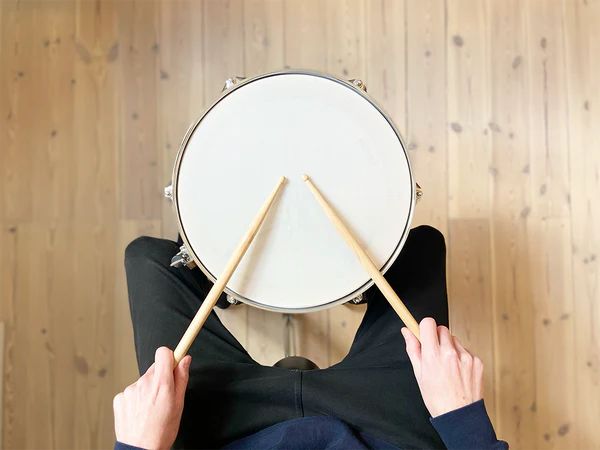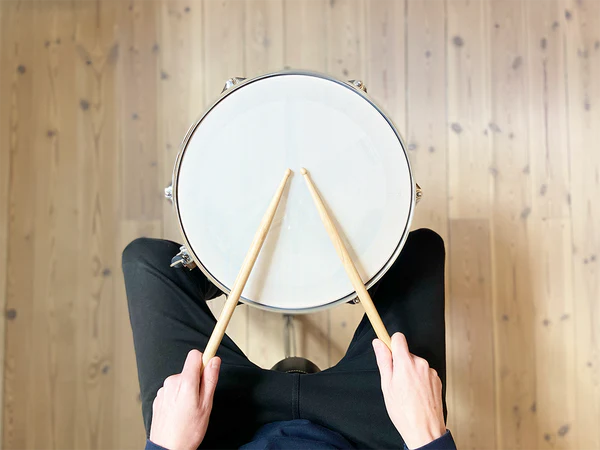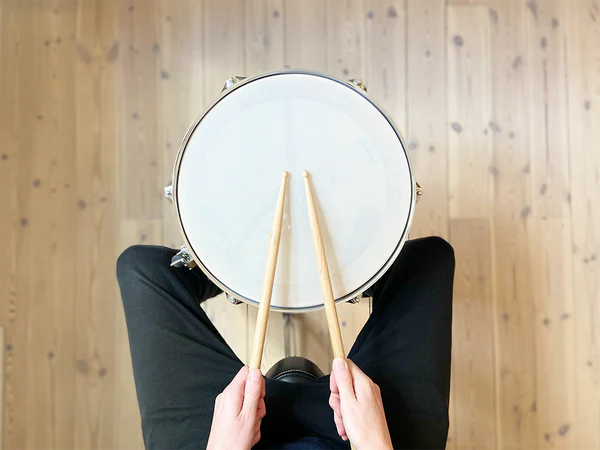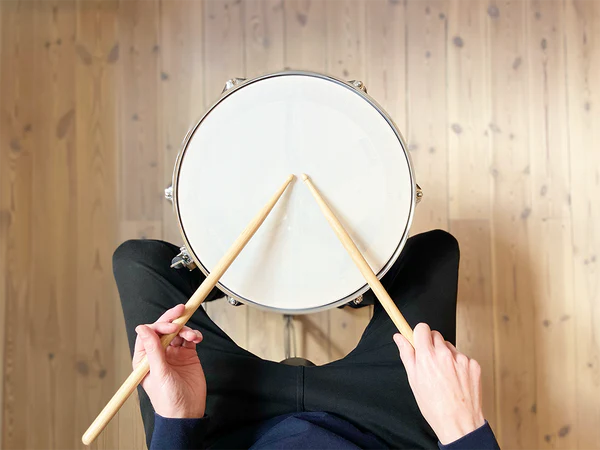How to Hold Drumsticks

Before we dive into the intricacies of drumstick grips, take a moment to become aware of your body’s position. As you move around the kit, your hands will naturally shift. This is perfectly normal, and you should feel free to make adjustments. Once you’re comfortable, it’s time to explore the world of drumstick grips, a key element in elevating your drumming technique and overall performance.
The Importance of a Good Grip
Why does holding drumsticks properly matter? Well, the way you grip your drumsticks directly impacts your sound, control, and physical well-being. If you grip too tightly or force your hands into unnatural positions, you can increase your risk of injury and limit your fluidity around the drum set. A proper grip gives you the freedom to move naturally, allowing for more dynamic playing and reducing strain on your body.
Exploring the Different Drumstick Grips
Let’s take a closer look at the types of grips that drummers commonly use:
Matched Grip
The most versatile grip, where both hands hold the sticks in the same way. This grip is suitable for a variety of music styles like rock, pop, and jazz, offering balance, control, and adaptability.
Traditional Grip
This grip has deep roots in jazz and marching band drumming, where the left hand holds the stick in a unique underhand position, while the right hand typically uses a matched grip. The traditional grip offers more finesse, particularly for intricate snare work, and allows for more subtle ghost notes, accents, and dynamics. Its origins date back to marching drummers, who played with tilted drums slung over their shoulders, making the underhand grip more ergonomic.
The Three Matched Grip Positions
There are three main matched grip positions: German, American, and French. Each one offers its own advantages, and many drummers switch between them depending on what they’re playing. Let’s break them down:
German Grip
In German grip, your palms face downward. This grip is known for delivering power with every hit, making it ideal for heavy drumming styles like rock or orchestral performances where volume and impact are key.

American Grip
In American grip, you rotate your hands slightly upward. This grip offers a balance between power and control, making it the most versatile and popular choice for many drummers across a variety of genres. It’s a solid “base” position that’s comfortable for most drummers.

French Grip
With French grip, your thumbs are positioned on top of the drumsticks with palms facing each other. This grip gives you greater control and is often used for intricate playing or softer strokes, perfect for jazz or other nuanced styles.

Step-by-Step: How to Hold Matched Grip
Mastering your grip starts with understanding your natural hand position. Follow these steps to find a grip that’s both comfortable and effective:
Step 1: Find Your Natural Hand Position
Relax your hands by your sides and let them dangle naturally. Notice the position your hands take, this is your body’s most comfortable starting point.
Step 2: Bring Your Hands Up
Gently raise your hands while maintaining a relaxed posture. With one hand, grab a drumstick and place it in your other hand, allowing it to rest naturally.
Step 3: Find the Stick’s Fulcrum
The fulcrum is the point where the stick balances on your fingers. Drop the stick onto a drum and count how many times it bounces. Adjust your grip until you find the point that allows for the most natural rebound.
Step 4: Choose Your Fulcrum
Different drummers prefer different fulcrums. You might opt for a middle-finger fulcrum, an index-and-middle combination, or an index-only fulcrum, whatever feels most comfortable for you.
Step 5: Adjust Your Grip
Hold the stick firmly, but not too tightly. There should be enough space between the stick and your hand for the stick to move naturally as you play. You want to avoid over-gripping, as it can hinder your performance and cause discomfort.
Step 6: Repeat with Your Other Hand
To make this a matched grip, repeat the process with your other hand.
Step 7: Try It Out
Now, practice playing around the kit. Experiment with different positions and grips until you find the one that feels most natural to you.
The Benefits of Matched Grip
- Versatility Across Styles: Matched grip is the most adaptable grip for modern drummers. Whether you’re playing rock, pop, jazz, or metal, this grip allows you to switch between different styles effortlessly. Its balance and symmetry make it a go-to for drummers in a wide range of genres.
- Power and Control: Matched grip provides equal strength and control in both hands, making it ideal for powerful drumming. Whether you’re playing hard-hitting beats or quick, intricate patterns, the evenness of matched grip ensures both hands can deliver consistent, controlled strokes.
- Comfort and Balance: For many drummers, matched grip feels more natural and intuitive. The uniformity in both hands helps maintain balance and ease of movement, allowing you to play more comfortably for longer periods without excessive fatigue or strain on one side.
- Efficient Technique Development: Since both hands hold the sticks in the same way, matched grip simplifies learning new techniques and rudiments. This grip makes it easier to practice and improve hand independence, speed, and precision, particularly for beginners and those focused on faster playing styles.
The Traditional Grip
While the traditional grip might look unconventional, its design is purposeful, stemming from the era of military drumming and classical percussion. In this grip, the left stick is held with the palm facing upward, while the stick rests between the thumb and index finger. The back three fingers provide additional control and movement. The right hand typically uses a matched grip, offering a balance of power and finesse.

Step-by-Step: How to Hold Traditional Grip
Mastering the traditional grip may feel a little tricky at first, but with practice, it becomes second nature. Follow these steps to hold the traditional grip properly.
Step 1: Start with your natural hand position
Let your left hand dangle by your side and relax. Slowly bring it up in front of you as if you were shaking someone’s hand, keeping your wrist loose and relaxed.
Step 2: Place the stick in your left hand
Slide the drumstick into your left hand so it rests between your thumb and index finger. The stick should lie on the fleshy part at the base of your thumb, with the tip pointing forward and the butt resting near the base of your hand.
Step 3: Position the stick between your fingers
The stick should rest between the first joint of your middle finger and your ring finger. Your index finger will wrap lightly around the stick, while your thumb sits gently on top, acting as a guide.
Step 4: Support with the remaining fingers
Curl your ring and pinky fingers underneath the stick. These fingers don’t grip the stick but provide extra support. The middle and index finger do most of the work in controlling the stick, so keep them in contact without gripping too hard.
Step 5: Find the stick’s pivot point
To get the most natural rebound, experiment by lightly tapping the drumstick on a snare or pad. Adjust the position of the stick in your hand until you find the balance point where the stick moves smoothly and freely.
Step 6: Keep your grip relaxed
Hold the stick securely, but don’t grip too tightly. Your left hand should feel loose enough to allow finger movement but firm enough to maintain control. The key to traditional grip is using your fingers to finesse the stick, not your wrist.
Step 7: Right hand uses matched grip
Your right hand will hold the drumstick with a matched grip (American, German, or French) for balance and power, while your left hand focuses on more nuanced control with the traditional grip.
Step 8: Try it out
Once both hands are in position, start playing on the snare or practice pad. Focus on building control and precision with your left hand while maintaining power and fluidity with your right. Experiment with ghost notes, accents, and rolls to see how this grip changes your playing.
The Benefits of Traditional Grip:
-
Finesse and Articulation: Traditional grip allows for more controlled, subtle strokes, making it perfect for jazz drumming, where delicate accents and ghost notes are vital.
-
Snare Precision: Marching band drummers appreciate the accuracy and control this grip offers, especially when performing complex rudiments or sticking patterns on the snare drum.
-
Historical and Aesthetic Appeal: Many drummers, especially in jazz, continue to use the traditional grip for its historical significance and its distinctive look, adding a level of artistry and expression to performances.
Finding the Right Grip for You
Whether you choose matched or traditional grip, each has its own advantages. Matched grip offers symmetry and power, while traditional grip provides finesse and style. The key is to experiment with both, finding the grip that best suits your drumming style and musical preferences.
Preventing Injury and Fatigue
Holding drumsticks properly not only helps improve your sound, but it also prevents injury. Drumming is physically demanding, and if you’re gripping incorrectly, it can lead to strain in your wrists, hands, and arms. Over time, this can result in repetitive strain injuries, making it harder to play for extended periods.
A relaxed grip helps you play for longer without experiencing discomfort or fatigue. This is crucial, especially during long practice sessions or live performances where endurance is key. Plus, mastering the right technique early on lays the foundation for advanced skills like speed, precision, and control.
Common Mistakes to Avoid
Here are some pitfalls to watch out for as you refine your grip:
- Over-gripping: Avoid holding the sticks too tightly. A loose, flexible grip gives you more control.
- Incorrect thumb placement: Keep your thumb in line with the stick for better control and comfort.
- Holding the sticks too far back: This reduces your control and power. Always check your hand placement to ensure the best balance.
Conclusion: The Power of a Good Grip
Holding drumsticks correctly might seem like a small detail, but it’s the foundation of all great drumming. Whether you’re just starting out or looking to refine your technique, spending time on perfecting your grip will pay off in the long run. So, grab your sticks, try out these steps, and find the grip that unlocks your drumming potential.
If you're interested in trying Freedrum Studio, there's a special promotion available. Use the code: DRUMSFORLIFE at checkout to get 30 days of access for just $1. It's a great opportunity to explore the platform's unique features and see how it can help you improve your drumming skills.



